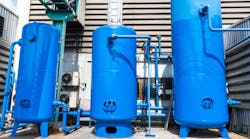How to collect and utilize compressed air system data
Neil Mehltretter is Technical Director for Kaeser Compressors, and he has conducted and supervised thousands of industrial compressed air studies to help plant teams achieve significant energy savings and operational improvements. Werner Rauer is the Project Manager for Oil Injected and Oil Free Screw Compressors at Kaeser Compressors, and he's an active leader in the Compressed Air and Gas Institute, where he helped develop the widely used CAGI compressor data sheets. In this episode of the Compressed Air Podcast series, Neil and Werner explore the benefits of knowing what is going on in your compressed air system.
PS: We're discussing compressed air system data monitoring, and Werner, I'm going to throw this first question to you. What are the most important things to know for our discussion today when it comes to a compressed air system.
WR: There are certainly a large number of items that people would like to know about the .compressor system. And they certainly vary or expand depending on who is asking or looking for information, like maintenance personnel, plant managers, corporate, and even the equipment manufacturers. So let's take a look at the top tier items. We're talking about the compressor system, so first and foremost, is the system pressure, period. Everybody knows that when the pressure is low, that things either have gone wrong, or are about to get worse. Pressure readings that are too high are quite rare, but also indicating trouble. And low pressure alarms are the most common alarms in a system. Next would be any alarms or warning messages or indicator lights on the key components, like compressors, dryers, filters, specific sensors, like a pressure dewpoint monitor, for example, valves, etc., that are equipped for this and installed in your system for a reason. Operating and service hours, and possibly some temperature readings are items of interest as well. And nowadays, this will be followed by energy data like power and flow at pressure, resulting in a specific power number as well. That could be for the entire system or for each compressor individually and other energy consumers. And it may also include water consumption, if the equipment is water cooled. At the end, it is the historic data of these things that makes it even more useful.
PS: Well, to follow up on that question a little bit, what's the best way to get that information and all that data from a compressor system?
Neil Mehltretter
NM: Sure. You know, pulling the data from the individual compressor controller or better yet a master controller directly is going to be the best method to understanding all the points that Werner mentioned in question one. It's funny because Werner and I spent a few minutes yesterday talking about digital signals and analog signals and the difference between them, but individual controllers and master controllers are taking stock of hundreds of data points a second, both analog and digital. Master controllers are really important because it's a one-stop-shop for all your data sources. So your compressors, your dryers, your drains, it could be louvers or extra signals, like Werner mentioned, could be flow, could be pressure dew point, and this data can then in turn be sent to the customer's DCS or plant control system for further evaluation.
There are so many protocols out there right now for customers to pull data; it depends on what you have. But typically it's Modbus, or EtherNet/IP. I’ve seen a lot of interest in OPC UA right now, Profinet, as well as BACnet, to name a few. So it's just a matter of how that data is trending, like Werner said, what's the history? We know what's happening now because of that alarm, but what precipitated that alarm? And so, that data coming to the customer, how is it coming? Is it coming right to their inbox? Is it coming through in an app? Those are things that that we're starting to see. And customers are very interested in the operating temperature of that equipment, or the room, especially also with flow. So flow during off-shift or downtime, whatever that leak rate may be. So those are the things that I think we're starting to see getting that information and viewing that information, starting to become paramount.
WR: Yeah, if I may add something there with the today's equipment in 2022, that should include modern controllers that not only have those sensors that you mentioned, but also provide local storage, as well as communication ports to move the data. These extra sensors are becoming more common, more and more, maybe because the prices get lower. But it's absolutely on everybody's list, maybe because they realize more and more the benefits of knowing what is going on in their compressed air system. In my mind, it's also important where the data is stored, and how quickly it is pulled for me to look at like a dashboard or a front-end browser app or your cell phone.
PS: So Werner, you helped us understand what's most important. And Neil, you talked about how you can collect and pull that data. So what's next? What can customers then do with that data?
Werner Rauer
WR: Yeah, that's a great question, if not the question that everybody is asking. Most customers so far, meaning a few years back, have been happy to get the basic information on those top tiers that we discussed earlier. It's like driving a car. You get some analog values, like speed is the most important and some indicators or indicator lights or messages. Or let's make this even simpler; green is all good. Yellow needs some attention and planning. Red, however, that requires immediate action. Since most people do not want to babysit their station 24/7, typically, that master controller is employed as Neil mentioned, and that is supposed to provide that simplified interface for the end user or customer. Add a modem or other communication ports to connect to the intranet or Internet, and you will receive those messages in real-time, perhaps also allowing you to view the overall status online and act immediately and properly...having pinpointed a target issue. Having countdown maintenance hours allows for the planning and servicing of the equipment.
Pressure graphs, over time, make it easy to find those low spots to investigate what was going on with the rest of the plant that's using compressed air at that particular time. You may realize that you simply lost a compressor or a valve was stuck open, or you simply are exceeding the capacity of your compressors. Knowing how low the pressure drops enables you or us to size up the missing capacity and plan for the expansion with way more confidence than just guessing.
If air quality is important, the minimum would be to look at the pressure dew point curve, watching out for irregularities. Perhaps finding out that every day when the ambient temperatures goes above 90, the values just keep creeping up. And before something shuts down, you may want to call in, make a call for cleaning up the heat exchangers of a refrigerated dryer. Or finding that the drain gets stuck every once in a while causing those dew points spike. So similarly for compressors, they may struggle with increased ambient temperatures and either need a good cleaning, which you can then schedule or perhaps identifying a thermal shortcut on just one compressor with ducting or that the exhaust fan of the entire compressor room stopped working. Going further, statistics on your system coming off of that data can provide overall cost and efficiency values, allow targeting of inefficiencies of a particular compressor or other components for all of them, you can confidently reduce the main pressure setting on your master controller to save energy, and watch how the system and your manufacturing plant reacts. So basically, data monitoring allows for optimizing your system, perhaps with the help of a system expert.
Listen to the entire interview
NM: I think what Werner said was perfect, especially that last piece. How do you know what these target values should be? So what's that specific power supposed to be? And then what is the best pressure for you to run at duty cycles on the compressors, operating temperatures of the compressors? Those are things that we'd always recommend for the plant to determine with your compressed air provider to figure out. This the baseline that we want to hit. How can we get there? So, if you can't measure it, you don't know what it is? So measure it, then let's figure out, what is it on paper? How close is it to what we want it to be? And then how do we get there? So those are really powerful tools.
PS: Okay, so as a follow up to that, what about manufacturers? What can they or other third parties do with that data? Is it useful to them as well?
NM: It absolutely is. I think we're going to give you some great examples of what can be done with this data in real-time. I think the goal for manufacturers is to understand how the equipment is in operation. So when we start talking about fixed speed compressors, we want to ensure that those units are running 100% loaded or off. And so those are things that we would want to be looking for. And that will help us understand what failures we might be seeing at a customer site that are surprising. So if we can say, this cooler has a leak in it. Okay, that's a surprise. We wouldn't expect that to happen in this amount of time. What's that duty cycle? The individual controller certainly has that information in there, but we may not be able to see the short cycling of that compressor. So, with that data, being able to dial in or getting data packets out, we might be able to see those trends. So, if it's a 24-hour type of uptime system, then absolutely the manufacturer or the service provider would want to be getting those messages and alarms to ensure that the customer is completely operational.
Now, Kaeser has our own segment, our utility business where we own the equipment, and we're servicing the equipment, and we're guaranteeing an uptime for our customers. So those are really important for us. And for our business model, we want to make sure that everything is a go. So from a customer standpoint, or from a third party, it's also asking, when that service due? So maybe we're going out there every two weeks to ensure that the system looks good. But if it's three or four hours away, we want to be able to dial in and say, well, when is service really going to be due? And a lot of cases, what we find is, customers are busy doing what they normally do, and they may not be able to answer the phone and tell us what those service hours are and how close we are to the next service. So we may end up getting there. And we can do service on one compressor, but not on the second one. And, we want to consolidate those trips. And, typically, with a master controller, we'd be able to do that (consolidate trips). So being able to dial in and pre-scheduling and calling a customer and saying, hey, it looks like you're going to be ready for service in two weeks, let's get you on the schedule. Because right now, that's how long we're built out. And that way everybody's able to plan going forward. So it’s pretty powerful stuff that's out there right now.
WR: Well, manufacturers or compressor systems specialists can certainly help the customer in analyzing the data and provide recommendations, which by no means should replace a system audit, including a walkthrough. At least you have to do this one time to get familiar with the customer system. Manufacturers use the actual system data for a number of things like, for example, verifying how their control modes actually work in a live real system and allow for creating new ones or optimizing existing control modes. We also look at the data to develop algorithms for our master controller. And now we can just watch and see what this chess computer decides to do in a live system. And one more note, every system is different.
PS: Definitely. Thank you, very interesting. I especially appreciated the information about the utility business. I think that's a business model that is really important these days, and you're seeing it more and more. So it ties in definitely with what we're talking about today. So another interesting question here that I'm going to throw to you guys. What is the most interesting thing that you've learned or seen in a system via a remote feed?
WR: Where do I start, I have very limited time. So let me take that one, since you mentioned SAU, so one of our SAU systems, those are all about reliability and uptime that we guarantee, as Neil mentioned, so we have one with all three machines with an integrated heater compression dryer, and we monitor them 24/7. So we see dew point spikes, send us a message. Looking at the stored data, we are looking for patterns. And at the end, we had to basically invite the design engineer who's stationed in Germany. And he determined that the intercooler drain failed occasionally, but with no error message. So that was absolutely new to us. And he helped us figure out and how to get to the bottom of this. And that failed drain allowed the liquid water downstream in causing those spikes. So that certainly resulted in a very thorough investigation, or root cause analysis, and it has been resolved. And it will now benefit future customers.
We had another system running beautifully for three months; they have three dryers in the system. And first one of the dryers gave way, then the second one, and the third one looked pretty bad because it was basically overloaded since the other two were down. So the customer was not even aware of when our tech arrived. And he found that a contractor who installed metal guards on those dryers had accidentally drilled into the condenser and caused a refrigerant leak. So that certainly was a plus for our customer here, that we were able to spot this trouble remotely and be there before he even knew about it.
And there's one more, if I may share this, we just started a big system with three large variable speed compressors with a master controller. During that startup, we could see that one of the machines did not behave as expected or definitely not like the others. It did not vary in speed at all. So after some deep digging from remote, we found that it was mis-programmed by accident, like a fat finger job. But we caught it right here by looking at the data. And then later on, we could watch remotely just how this master controller manages those three variable speed drive machines very well. And we improve the efficiency just by asking the customer to lower the system pressure, with the confidence that step-by-step, we can be there with him. And after a few weeks, we are now down at 84 to 85 pounds where he was planning on running it at 105 psig and everything is okay, so that is my story. And I'm sticking to it.
PS: Okay, thanks for those examples. So one last question today. Can you explain in more detail why more and more companies aren't offering this type of service?
NM: So if I had this answer to broaching that digital divide, I think we'd be having a very different conversation right now. I do believe it's close. I think it's coming. We all look to our cell phones constantly. Some of us have to put them away to make sure that we're not distracted. Whether it's news or family updates, work emails, there are ways to push your compressed air system alarms and messages to your cell phone and have a web browser app that's going to show you the status of that system. So I think that technology is there; it's just packaging these things together with the necessary support structures is maybe the missing link. There are of course challenges with adding a third party to that system, so you might have the company, you might have the monitoring device and then the monitoring person or group. And usually that cellular is also a challenge. It's not great in every location in the U.S., regardless of what Verizon or AT&T may say, so there are places that compressed air systems go that cellular does not. Plus there are some folks that are concerned with the security of cellular and in those cases, we need some kind of alternative. So I think we’ve got to find that right tipping point to really move this business model forward.



